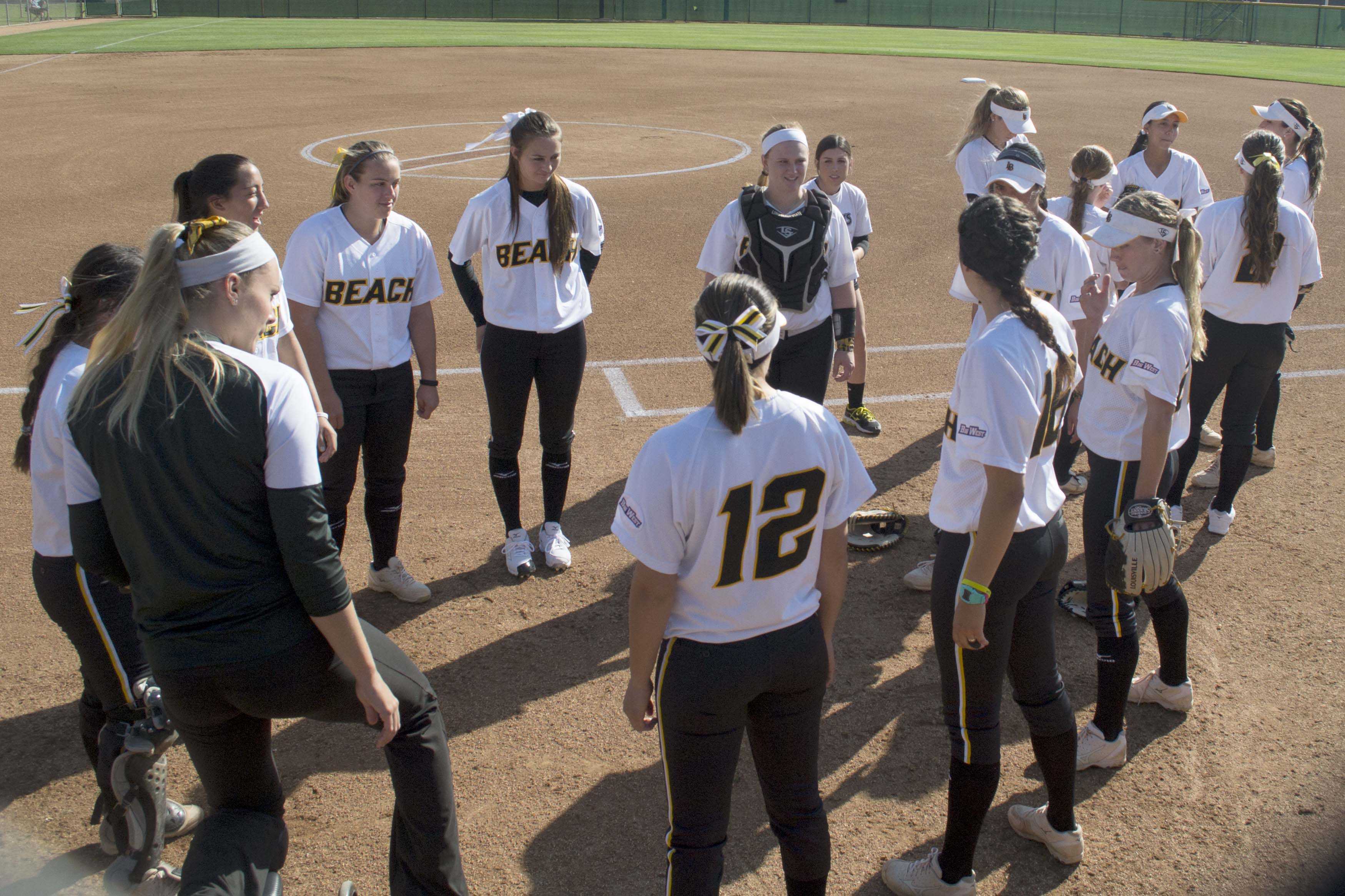The scrum of athletes sways shoulder-to-shoulder with arms interlocked. The black and yellow ring counters the softball-clad ringmaster’s calls with a roar, amplifying the raucous game of call-and-response to its climax.
Before every game, the Long Beach State softball team rallies together for a traditional, pre-performance ritual, passed on from last year’s lineup.
“I don’t know how or why it started,” sophomore infielder Lauren Lombardi said, explaining that sophomore catcher Monique Dyer now leads the routines. “But I’m really glad we keep doing it because it gets our energy up.”
Pre-performance rituals have become popular areas of study in athletics due to legends like baseball Hall of Famer Wade Boggs.
In the book “Believing in Magic: The Psychology of Superstition,” psychologist Stuart Vyse notes that Boggs developed a five-hour routine before his games. This involved eating chicken, running wind sprints in the outfield at 7:17 p.m. during warm-ups and drawing the Hebrew sign for “Chai,” meaning “life,” in the dirt with his bat before stepping up to the plate.
Many of baseball’s subculture superstitions—the lucky socks, sleeping with the bat, the game-day boxers—are indirect coping mechanisms that provide comfort in the guise of useful magic tricks.
Rituals like these expand beyond athletic endeavors, and span across many performance-based platforms for CSULB students.
Junior Jennifer Serda, a horn performance major at CSULB, channels an indirect stimulant by reading amusing Cracked.com articles and listening to comedy acts before she heads to the stage.
“Some stress is inherit and natural—it’s going to happen,” Serda said. “But I’ve found that a lot of extra stress comes from being unprepared.”
After 30 to 60 minutes of warm ups and additional time to setting up, Serda takes about 10 to 15 minutes to loosen up with laughter.
“It’s not superstitious, it’s just something I like to do to relax,” Serda said. “I really enjoy performing, so it’s a fun thing to do; I’m usually just ready.”
Though the act isn’t directly embedded into her routine, the lack of magical significance to Serda is what makes this a pre-performance ritual rather than superstition, based on Vyse’s findings.
In a 2014 study of 20 male semi-professional soccer players from the European Journal of Sports Science, researchers stated that although the mechanisms of the process have yet to be fully understood, they can be directly linked to stress levels.
The athletes were divided into a control and experimental group, and mental awareness tests analyzed their performance, anxiety and self-efficacy. Based on the study, participants of the experimental group showed lower anxiety levels and an increase in self-efficacy while the performance of the control group suffered.
Sophomore Brandon Ayala, a business major at CSULB, hosts a talk show and DJs for K-Beach Radio. He has worked as a DJ for Sevilla Nichtclub, for corporate Victoria Secret events and for Home Depot, despite taking on turntables only two years ago.
“When I first started to do these events, my dad would always help me with my equipment to get my feet wet,” explained Ayala. “On the way [there], we would have these conversations; [but] when I got to the event I wasn’t focused.”
Since then, Ayala has initiated a “party mode” procedure, which involves strategic equipment placement in his pick-up truck on the way to an event and listening to a custom mix of his own original tracks 20 minutes before arrival.
“It’s definitely a psychological thing; I believe it helps me, [and] it makes me feel confident,” Ayala said. “If I didn’t do it, I don’t think anything bad would happen, but the way I would approach that event would be different.”
After blowing out his shoulder and his knee, TJ Rosas exchanged his college football career in Minnesota for a future in public speaking.
As a senior communications major at CSULB, Rosas serves as the secretary for CSULB’s Forensics Speech team.
“I [rehearse my speech] really fast, [then] I do it really slow; sometimes I’ll do it in like a really funny accent,” Rosas said, referring to his threefold process of pre-performance repetition. “You just got to play with it.”
He said that the physical aspect of his warms up aim to modulate vocals notes by hitting all levels and tones and to stretch his face muscles.
Before competitive events, Rosas and his team circle up in an empty classroom for energy warm ups, starting with vocalized syllables of a foreign tongue.
“There’s this weird game where we do every syllable of the alphabet minus the vowels,” Rosas said. “It kind of goes like Bah-buhbuh-bah-buh-bah-bahbah, Cah-cuhcuh-cah-cuh-cah-cuhcuh.”
In addition to running through speeches, the group engages each other with adrenaline-fueled chanting.
“Do you have the energy? I have the energy!” Rosas accounted from their vocal drills. The team walks out after cheering, “We’re all qualified members of the LBC. Go Beach!”
From mash-up masters on live radio to oraters and the arts, pre-performance rituals affect performers outside of the athletic realm like the dirt-diamond Dirtbags.




